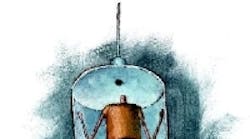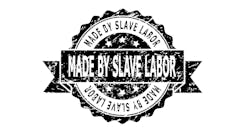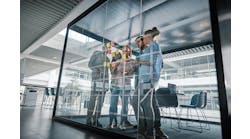When it comes to employee drug use, the statistics should make any business manager or owner sit up and take notice. Ten percent of fulltime workers in the United States currently use illicit drugs. Employed drug abusers cost employers twice as much in medical and workers' compensation claims as do drug-free employees. Studies show that substance-abusing workers are five times more likely to file a workers' compensation claim, and almost four times more likely to be involved in on-the-job accidents. Sub-stance abusers are late for work three times more often than non-abusers, and are one-third as productive as non-users.
There's a misconception that drug abuse in the workplace is tapering off, says Peter Cholakis, vice president, Avitar (Canton, Mass.), a manufacturer of drug testing devices and related services. "At the end of the [President Ronald] Reagan era, positive, pre-employment drug tests peaked at 14%. Then the drug-free workplace and 'Just Say No' campaigns started and the current positive rate is 4.5% in preemployment tests.
"If you overlay those [declining line] graphs with ones showing rising rates of Internet use, you can see what happened. People found better ways of cheating [on the pre-employment tests]," says Cholakis.
The average drug user is a white male, age 30 to 35. The construction industry has the highest rate of drug abuse; one out of every four construction workers admits to using illicit drugs in the past year. In manufacturing 15% of employees admit to illicit drug use. According to the U.S. Department of Labor, 73% of drug abusers in this country are employed. This means that 8.1 million drug abusers are on the job, right now.
Cholakis says about 10% of major companies began random drug testing of worker populations within the past three years. Such programs are expanding because of the results: Accidents in companies that have implemented random drug testing programs have dropped nearly 50% and inventory shrinkage has shrunk by 50%. "These are individual companies reporting to us, not companies filling out a required government survey form," says Cholakis.
He cites another interesting research finding; more than 90% of employees prefer a random drug testing policy because they understand that workplace violence is linked to drug abuse.
"Our employees welcomed the random testing," says Bob Rivenburgh, human resources manager at Kaymark Corp. (Fonda, N.Y.). "In a heavy, labor-intensive industry like ours, employees know they have a right to a safe, drug-free work environment."
Kaymark is in the aluminum extrusion business. It has been doing random testing via oral fluid samples for several years now.
Oral fluid tests vs. urinalysis
While random testing is growing in popularity for existing workforces, most drug testing is conducted for preemployment screening. Urinalysis remains the most common method of testing. A urine test costs about $35 per test. The applicant is typically sent to a collection site to donate a urine specimen. After three or four days the hiring company gets the results.
A number of things happen in that three-to four-day period, and companies in areas with labor shortages don't like most of them. "About 20% of those candidates never report to the testing site," says Cholakis. "They go someplace else to be hired. Or, they take a day or two to report, clearing some drugs from their systems, or look for a way to beat the test."
Urinalysis isn't necessarily the best testing method because it's difficult to administer and it's somewhat invasive. The urine test is also open to cheating unless there is direct observation of the donor. "Oral fluid tests offer a number of advantages," says Cholakis. "It produces as many negatives and positives as urine testing, however, oral fluid tests detect current use of drugs, whereas urine tests measure metabolites in the person's system."
What this means is that it takes a certain amount of time for drugs to work through a person's body. A lift truck operator could abuse cocaine, drive his truck into a wall, take a urine test and it would show up negative. Oral fluid tests can detect drugs in the operator's system within minutes of ingestion.
Random testing using oral swabs costs about $20 per test. Compared with the urinalysis it formerly used, Rivenburgh says switching to oral swabs cut the company's testing costs by about two-thirds. Another benefit of oral fluid tests is that they are non-invasive and easy to administer.
"My staff does not even get involved in touching the equipment—other than to open the packet [containing the swab]," says Rivenburgh. "It's basically a self-administered test, done by the applicant in front of the staff member."
If the sample shows positive results for one or more target drugs, a second test is conducted for each identified drug class. The confirmation test uses a different, more sophisticated chemical process. This makes sure that over-thecounter medicines don't cause false positives. Each step of the confirmatory process is documented with a chain-of-custody form.
Switching to the oral fluid method for pre-employment testing also gave Schneider a competitive advantage in a tight labor market. "In pre-employment tests, I have results in a couple minutes while my neighbor companies are still waiting two or three days," he says.
Is random testing random
The drug usage numbers above should be impetus enough to start a drug-testing program. Companies with random drug testing programs have reduced the substance abuse problem within their companies to sub one-percent levels. The bad news is those drug abusers have gone somewhere else to work, not to rehabilitation centers.
"We have a population of about 1,000 employees," says Rivenburgh. "We randomly test once a month and reach about two percent of the workers from the top to the bottom. No one is exempt."
He adds that, because the selection is random, a person could be tested three or four months in a row. "This sends the additional message that, because a guy has passed the test this month, doesn't mean his turn won't come up again. They know someone is watching."
According to the Drug and Alcohol Testing Industry Association (DATIA, Washington, D.C.), more than 12 million employees are subject to mandatory drug testing under U.S. Department of Transportation (DOT) regulations. A concern about the DOT's random testing is that it's not really random. Drivers may be selected for testing by chance, however they have up to 48 hours to report to a place for testing. What can happen during that 48-hour period is what concerns users of the DOT program and it is why some want to make it more stringent.
Don Osterberg, v.p. of safety and driver training for shipping and logistics company Schneider National (Green Bay, Wis.) says that he does not feel the time lag between driver selection and testing is a problem.
"We randomly test about 50% of our driver-associates each year," explains Osterberg. Last year the company administered about 28,000 drug tests. "In addition, we randomly test 10% of the fleet for alcohol each year."
Osterberg describes the Schneider program as a three-legged stool. There is random testing, post-accident testing and reasonable-suspicion testing.
"In addition," says Osterberg, "we do pre-employment testing for all employees, and random testing of shop, or maintenance employees."
Currently Schneider uses urinalysis as the method of choice for testing. Osterberg says he is looking at the benefits of hair-sample testing because illicit drugs can remain in the hair longer than in bodily fluids in some cases.
The Schneider testing program, like that of the DOT, has no tolerance for any illicit drug usage. "We treat a refusal to test, or a missed test date the same as a positive result," says Oster-berg, "immediate termination."
Positive results from a program
What kind of return on investment from random drug testing can a manager expect? If each drug abuser costs $8,000-$10,000, and 10% of the employee base is abusing drugs, those people can easily cost an employer of 100 or more upward of $100,000. The kit for testing costs between $20 and $30. It's easy to see the payback.
When implementing a testing program experts suggest talking with colleagues in similar businesses and within the same region of the country. Another important aspect of starting a testing program, suggests Cholakis, is buy-in from top management. It begins with baseline testing of all employees from the chairman of the board on down. "We have examples of companies that have announced a drug testing program to begin within 90 days," he says. "Even forewarned, 30% or more of the employees test positive."
Those kinds of statistics can scare some executives. The possibility of having to replace 30% of the workforce is enough to kill a program before it begins. "What we've discovered, however," says Cholakis, "is that among those with huge losses of employees, companies actually show productivity gains with fewer employees."
Schneider's Osterberg admits he is not a fan of outsourcing. He makes an exception for drug testing. "The technical and managerial aspects of drug-testing programs require a neutral point of view," he says. "And if the third party does not actually run the program, it should at least help set up the program."
For those wanting to establish a program, or learn more about what's available, the nuts and bolts of a random drug testing have become less challenging with the advent of government resources and templates available at department Web sites. OSHA and others can direct anyone looking for information to whatever they need.
However the program is structured, the company's drug-free policy must be available in written form, with clear objectives and what actions will be taken should an employee test positive, which is most often dismissal. Rarely do employers pay for rehabilitation. The policy should also explain what happens if an employee refuses to take a test.
One question that always arises when establishing a random drug-testing program is whether it's an invasion of privacy. Legal precedent has established that it is not. Assuming the program complies with federal, state and local laws, courts have determined that drug testing is not an invasion of privacy. The primary factor in the courts' decisions has been the safety and welfare of other employees.
Essentially, the employer has the right to establish a testing program for illicit drugs and alcohol and drug abuse. Under most circumstances, the types of tests, drugs tested for and cutoff levels can be determined by the employer—except in the cases of DOT-mandated testing. The employees' rights extend primarily to the right to privacy and the right to question the legitimacy of any test results. Depending on the state or local legislation, there may be other rights that employees are entitled to.
Kaymark's Rivenburgh says it's been his experience that people who test positive on a test are not the most important aspect of a drug testing program. "It's the person who is not a drug abuser, those concerned with working in a safe workplace, where the program has to focus." He says safety and a drug-free work environment are the issues he pursues, not catching drug abusers.
Illicit Drug Use In Lifetime, Past Year and Past Month among persons aged 12 and older | |||||||||
| Lifetime | Past Year | Past Month | |||||||
| Drug | 2002 | 2003 | 2004 | 2002 | 2003 | 2004 | 2002 | 2003 | 2004 |
| ANY ILLICIT DRUG | 46.0 | 46.4 | 45.8 | 14.9 | 14.7 | 14.5 | 8.3 | 8.2 | 7.9 |
| Marijuana and Hashish | 40.4 | 40.6 | 40.2 | 11.0 | 10.6 | 10.6 | 6.2 | 6.2 | 6.1 |
| Cocaine | 14.4 | 14.7 | 14.2 | 2.5 | 2.5 | 2.4 | 0.9 | 1.0 | 0.8 |
| Crack | 3.6 | 3.3 | 3.3 | 0.7 | 0.6 | 0.5 | 0.2 | 0.3 | 0.2 |
| Heroin | 1.6 | 1.6 | 1.3 | 0.2 | 0.1 | 0.2 | 0.1 | 0.1 | 0.1 |
| Hallucinogens | 14.6 | 14.5 | 14.3 | 2.0 | 1.7 | 1.6 | 0.5 | 0.4 | 0.4 |
| LSD | 10.4 | 10.3 | 9.7 | 0.4 | 0.2 | 0.2 | 0.0 | 0.1 | 0.1 |
| Ecstasy | 4.3 | 4.6 | 4.6 | 1.3 | 0.9 | 0.8 | 0.3 | 0.2 | 0.2 |
| Inhalants | 9.7 | 9.7 | 9.5 | 0.9 | 0.9 | 0.9 | 0.3 | 0.2 | 0.3 |
| Pain Relievers | 12.6 | 13.1 | 13.2 | 4.7 | 4.9 | 4.7 | 1.9 | 2.0 | 1.8 |
| Tranquilizers | 8.2 | 8.5 | 8.3 | 2.1 | 2.1 | 2.1 | 0.8 | 0.8 | 0.7 |
| Stimulants | 9.0 | 8.8 | 8.3 | 1.4 | 1.2 | 1.2 | 0.5 | 0.5 | 0.5 |
| Methamphetamine | 5.3 | 5.2 | 4.9 | 0.7 | 0.6 | 0.6 | 0.3 | 0.3 | 0.2 |
| Sedatives | 4.2 | 4.0 | 4.1 | 0.4 | 0.3 | 0.3 | 0.2 | 0.1 | 0.1 |
| Approximately 8% of the population has used some kind of illicit drug in the past month, and 15% has used in the past year. Note:Types of illicit drug use in lifetime, past year, and past month among persons aged 12 or older: percentages, 2002-2004. Illicit Drugs include marijuana/hashish, cocaine (including crack), heroin, hallucinogens, inhalants, or prescription-type psychotherapeutics used nonmedically. Nonmedical use of prescription-type pain relievers, tranquilizers, stimulants, or sedatives, does not include over-the-counter drugs. | |||||||||



